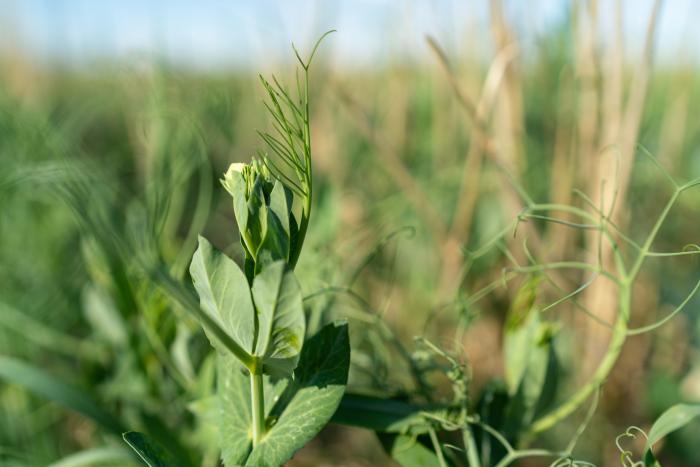Hawks Family Using Innovation and Soil Health near Galata

Cory and Belinda Hawks are progressive young producers deeply committed to regenerative agriculture, starting with their dedication to building soil health.
Watch their story on YouTube: Conservation for the Future: Regenerative Agriculture with the Hawks Family, Galata, MT.
Cory and Belinda Hawks are progressive young producers deeply committed to regenerative agriculture, starting with their dedication to building soil health. When asked by her husband what she thinks the biggest issue in the world today is, Belinda says without hesitation, “Global warming and reducing our carbon footprint. And it all starts with the soil. By making the soil healthier, we’re getting healthier crops, healthier people and that’s the goal – a healthier world.”
The Hawks’ soil health journey began in 2009 when they returned to north central Montana after college graduation. The couple purchased the ranch next to Cory’s dad Adrian; land that the family homesteaded since 1910. They added to their operation over the next few years and now manage 17,000 acres of range and farmland spread over twenty miles.
Adrian Hawks began working with NRCS over ten years ago through the Environmental Quality Incentives Program (EQIP) and Conservation Stewardship Program (CSP) for his ranching operations. “Both dad and my uncle have both been fairly innovative on what they were doing,” states Cory. “Dad has done a lot of cross fencing and water developments for the cows. He was probably more progressive on the cattle side of things than most of the ranches around here. So, we had a good base to start off with the intensive grazing.”
Currently the Hawks have 270 mother cows and 110 replacement heifers. “When I came back, we were running four or five different herds of fifty cows together, leaving them in a pasture for a month,” states Cory. “About two years ago, we put them all together into one herd and then last year we split up pastures with electric fence, moving them every three days. We now allow more rest time between grazing the pastures and that act alone has started to increase our species diversity.”
To save both time and labor cross fencing, Cory engineered a mobile, solar-powered electric fence trailer with plans to tweak the design and build additional units. “We can take the unit out with the four-wheeler and reel out a mile of fence in about seven minutes,” says Cory. “It works good for big moves. We use it for perimeter and cross fencing for smaller sections.” The Hawks are constantly striving toward improvement by developing innovative ways to work smarter and save on inputs. “We are trying to come up with easy solutions to make things work smoother,” states Belinda.
Despite a year of low precipitation, the Hawks feel positive about their progress so far. “This year we are experiencing a drought but we are considerably less stressed than we’ve ever been before,” continues Cory. The family’s lower stress levels can be attributed to soil health improvements and grazing practices they are implementing on their land. “When it’s not raining and you’re a conventional farmer you just sit around and talk about how it’s not raining,” states Cory. “Now we are out intensively grazing cattle. We have tightened up the rotations, so that we can keep more grass in front of us for longer because we know hay’s going to be short this year. It gives you the ability to change what you are doing so that you can actually have economic impact even if there is no moisture. It’s given us more security,” says Cory.
Cory’s ultimate goal is to graze more of his farmland. He looks forward to making this a reality with future EQIP contracts for more cross-fencing, wells, tanks and pipelines. “Once we get our infrastructure in place, we can change what we are doing significantly. It really opens up the possibilities of what we can do.” When referring to a yellow pea and barley intercropped field that may fail this year with no rain on the horizon, Cory continues, “If we had fence and water closer, it presents a lot of opportunity for both soil health and the economic side of things. It’s not going to make grain this year so I probably would just graze it and think of it as a soil health year.”

While improvements continue with the grazing rotations, Cory and Belinda are working to improve the soil health of farmland that has been worked hard for many generations. “Older generations didn’t know what they didn’t know,” states Cory. “We’ve learned so much about how the ecosystem works when you do things properly. We’re finding out that a lot of the practices they had back then were really detrimental. But it’s not their fault. It must have been significantly better then because no one had driven cows up here from Texas. But I think our grass is going to get better again.”
Soil health is an issue shared by producers across Liberty County. The local working group including the Conservation District, various partner groups and local producers identified soil health as the top resource concern in the county. This local priority drives NRCS’s Montana Focused Conservation which is used to target EQIP funds to make a difference on these local concerns. “We wrote a Targeted Implementation Plan (TIP) identifying the more progressive producers who have been to soil health workshops,” states NRCS District Conservationist Laurie Massar. “So, for this TIP, it required no-till with a disc drill and maintaining a twelve-inch stubble height, so a stripper header is needed.” Decreased soil disturbance and increased soil cover are 2 of the 5 soil health principles.
To meet the requirements of participating in the TIP, the Hawks purchased both pieces of equipment. They chose to use the EQIP funding from the TIP to make these purchases. “The disc drill and the stripper header are the two biggest changes we can do,” states Cory. “We worked a long time and didn’t gain any ground and now, after a few years doing it differently, we are getting a lot of soil cover and seeing improvements in the soil,” he continues. “The advantages of going no-till and the stripper header are moisture retention. We are impressed with how much sub-moisture we have now. We have been able to grow a crop that is better than it has been in a long time on significantly less moisture. And now we are starting to get some cover on the ground which is probably the first and most important step in our opinion.”
NRCS’s Massar agrees, “The longer we are doing this, we realize that these are critical steps. We’ve had a lot of people dabbling in soil health, but if you’re still using a hoe drill and you don’t have cover, you’re not gaining that much ground. At first, we didn’t know how important that was. But it is critical.”
In addition to less soil disturbance, keeping the soil covered and integrating cattle, the Hawks are working to keep a living root in the soil as long they can. The couple has seeded different species of corn, millet and sorghum-sudan. “There’s no history of warm season crops in this area,” states Cory. “Even the natives don’t have any warm season left in them due to over grazing a hundred years ago. So those grasses are a big part of our crop rotations.” In addition, the couple has added fava beans, vetch and chicory. “Just a few species like that can change things in a hurry. It has a cascading effect,” he continues. Recently they began intercropping to keep a living root in the soil and incorporate diverse species with various root structures. The Hawks are also introducing a diverse rotation of cash crops. “There wasn’t a lot of different crops in this area until recently,” continues Cory. “We are growing six or seven crops on our place where it used to be spring wheat, winter wheat, barley.”
“When you incorporate just one or two of the soil health principles, it can take five to eight years before you really see that system functioning at a higher rate,” states NRCS’s Massar. “The goal is to capture every drop of moisture that we get and get it in the ground and have it not run off. When you do it like Cory is, implementing all five principles – low soil disturbance, high diversity crop rotation, good residue cover, keeping a living root in the soil longer and adding the livestock component – it helps that soil biology and builds up soil structure quicker.”
As the Hawks continue along their soil health journey, their skeptics are coming around. “The neighbors who told me this was not going to work are calling me now and asking what I am doing,” smiles Cory. “It’s been a big turnaround in the last year. I believe if we are not using all the water and sunlight that’s given to us, we are wasting it. It seems like the soil is doing a good job even without the biology ramped up. Mother Nature wants to do it for us, we just have to get out of her way.”
More Information
To learn more about NRCS conservation assistance, please visit your Local Service Center or nrcs.usda.gov/montana, where you can also find contact information for the office in your county.

